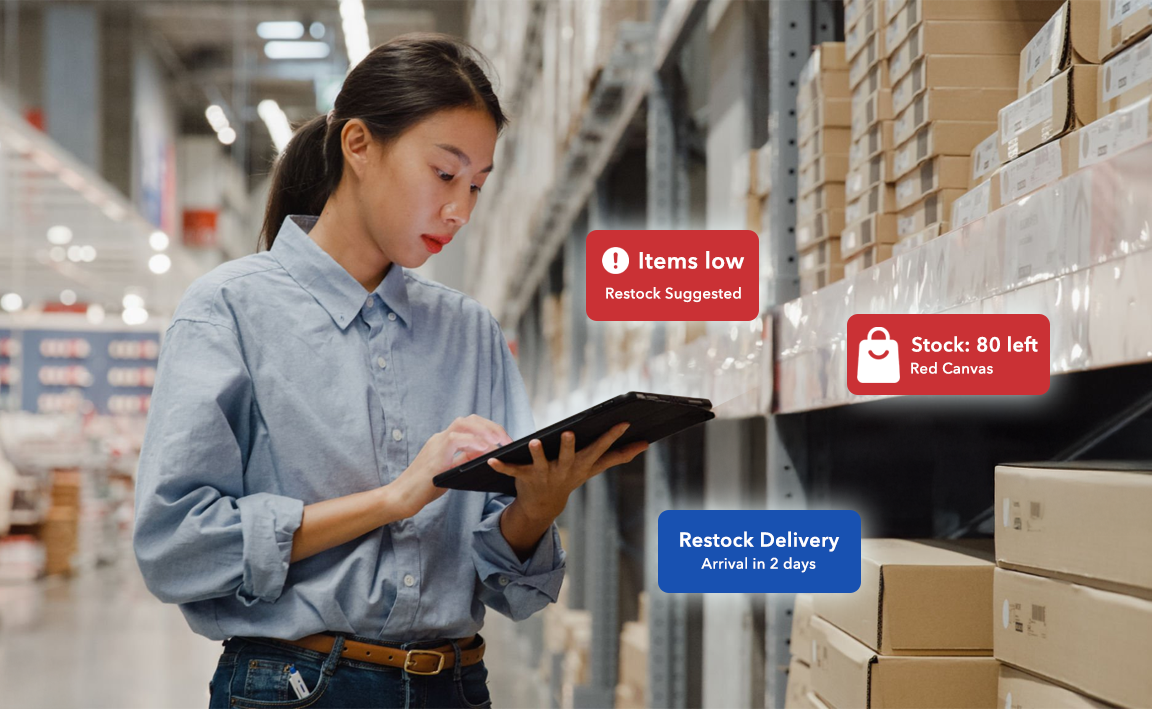Just-in-Time Inventory Management: When Is It Right for Your Business
Running out of space or stock too soon? Just-in-time inventory management could be your fix—cut costs and keep shelves stocked without the excess.

Managing inventory has always been a balancing act, but in a fast-moving market, the stakes are even higher. In high-density areas like Metro Manila and the Greater Manila Area (GMA), space is at a premium, and warehousing costs continue to climb. At the same time, customer expectations regarding availability and delivery speed continue to grow.
That puts pressure on supply chain and logistics teams: how do you reduce storage overhead without risking stockouts or delays?
That's where just-in-time (JIT) inventory management comes in. Instead of keeping large volumes of products, you restock only when needed. In this guide, you'll learn how JIT works, when it's a smart fit, and how to apply it to your operations.
What is Just-in-Time Inventory Management?
Just-in-time (JIT) inventory management is a strategy where goods arrive only when needed, thereby minimizing stocks in storage.
Initially adopted in manufacturing (by Toyota), JIT now supports retail, FMCG, and distribution industries, where fast turnover and efficient use of space are crucial. It's also convenient in modern trade formats, such as supermarkets, hypermarkets, and convenience stores, where shelf space is limited and product freshness is crucial.
Since warehousing is expensive and space comes at a premium in Metro Manila and the GMA, JIT is becoming a necessity. With reliable door-to-door logistics, even businesses outside city centers can now replenish stocks more frequently without incurring high storage or transportation costs.
Advantages of Just-in-Time Inventory Management

From cutting storage costs to keeping up with fast-moving demand, JIT inventory management can do wonders for your business. Here's what you can enjoy:
1. Lower inventory holding costs
Why rent space you're not using? Thanks to JIT, you keep fewer items in storage and free up capital and floor space for more productive use. In fact, when Harley-Davidson adopted JIT, the company cut inventory costs by 75%, freed up 25% of its manufacturing space, and even boosted productivity by 50%.
2. Reduced waste and obsolescence
Slow-moving products tend to lose value. With JIT, your deliveries follow actual sales patterns, allowing you to avoid excess stock, markdowns, and expired items. This approach is handy for perishables or seasonal items, such as FMCGs, cosmetics, or holiday stock—products that require rapid movement due to their short shelf lives.
3. Faster turnaround and cash flow
Since JIT inventory management only lets you bring in what you need, your products and sales move faster. You can use the available cash to cover operating costs, fund product development, or reinvest in other parts of your business—all while meeting customer demand.
4. More flexible to market demand
Trends change fast. Fortunately, with JIT, you're not stuck with piles of slow-moving stock. You can adjust your orders based on what your customers want and when they want it, helping you respond quickly to changes without wasting space or budget.
5. Stronger supplier coordination
Over time, JIT encourages better planning and regular communications across your supply chain. You and your suppliers know what to expect from each other, which means fewer delays or missed deliveries.
6. Less clutter
Fast inventory turnover keeps your storage space clear and your team focused. Instead of managing clutter or outdated stock, your staff can prioritize shipments and stay on top of daily orders. You get fewer delays and a work environment that's easier to control.
7. Easy scaling with demand
Growth doesn't always come with perfect timing, but JIT helps you stay ahead. Because you're not locked into massive storage commitments, your supply chain can grow step by step, alongside actual customer demand.
When is JIT the Right Fit for Your Business?
Just-in-time inventory management isn't a one-size-fits-all approach. However, when the conditions are right, it can ultimately benefit you. Here are the signs you should watch out for:
You serve modern trade retailers with frequent restocking needs
If you serve supermarkets, you're likely already restocking frequently in smaller batches. JIT supports this rhythm by syncing your deliveries to actual demand. This way, you don't send more stock than each branch can sell or store. It also prevents stockrooms from becoming too full and helps shelves get refilled more quickly.
Your products have a predictable demand pattern
JIT works well when your stock-keeping units (SKUs)—such as toiletries, over-the-counter medications, or pantry staples—move at a steady pace. With clear trends, it's easier to plan and restock without guessing.
You work with a reliable last-mile delivery partner
Frequent restocking, especially for bulky deliveries, only works when your shipments arrive on time. If your logistics provider delivers consistently and gives real-time updates, you're already set up for success. With dependable last-mile support, your inventory reaches its destination promptly, exactly when you need it.
Your inventory is not highly seasonal
If your product line doesn't rely on a single major sales window—such as holidays or back-to-school—you'll benefit from JIT's steady pace. It helps you avoid dead stock or overstocking.
You operate in or near logistics hubs
Operating in Metro Manila or GMA puts you right where inventory can move faster. With better access to routes and fulfillment networks, you can restock products without long delays or bottlenecks in your supply chain.
You have tight warehouse space or are seeking to reduce overhead
JIT inventory management helps you avoid storing too much stock. You can utilize your available space, time, and budget for more strategic goals, such as scaling your business or running operations more efficiently.
The Risks and Challenges of Just-in-Time Inventory

JIT inventory systems are efficient, but they don't leave much room for error. Without a buffer stock or built-in lead time, a single disruption can ripple through your entire supply chain.
1. Supply chain disruptions
Without backup stock, even a minor supplier delay can lead to major restocking issues. Port congestion, import and shipment delays, or weather-related setbacks can prevent products from reaching your customers on time.
Ninja Restock helps minimize this risk by providing frequent and flexible delivery options, allowing you to restock as often as needed without ordering in bulk. Our unmatched reach ensures that you can serve even the most remote locations reliably.
2. Over-reliance on perfect coordination between vendors and transport partners
JIT inventory management relies on your suppliers, logistics partner, and internal team working in sync. However, in reality, schedules shift, updates are missed, and delays occur. The more people involved, the harder it is to align everything and everyone.
Ninja Restock simplifies the delivery process with optimized routing, real-time tracking, and a dedicated account manager. Our advanced scan-to-print technology also eliminates the need for manual sorting, allowing you to process orders faster and more accurately.
3. Inventory stockouts from delivery delays or miscalculations
JIT doesn't leave much room for error. If a delivery is late or you miscalculate demand, you might run out of products fast. Empty shelves mean missed sales and unhappy customers.
With Ninja Restock's multi-point replenishment and co-loading model, you can ship smaller loads more frequently, reducing the risk of stockouts. We offer direct-to-store (DTS) deliveries to ship your goods on time.
4. Harder to react to sudden demand changes
If demand suddenly increases—such as during a sale, viral trend, or bulk order—JIT makes it difficult to respond quickly. Without extra stock, you risk missing sales when customer expectations are at their highest.
Ninja Restock allows you to adapt quickly with flexible shipping schedules and a pay-per-space model. Whether you need to send goods daily, once or twice a week, you can scale deliveries without renting an entire truck or overcommitting to large batches.
5. Modern trade pressure
Modern trade retailers follow strict restocking schedules. If you're late, you may face penalties or lose shelf space. Even a slight delay with JIT can upset your retail partners.
You won't have to face that problem with Ninja Restock. We can help you stay on top of frequent drop-offs, quick turnaround times, and efficient load handling. Whether you supply a supermarket, mini-mart, or sari-sari store, we ensure your shelves stay stocked and your retail partners stay happy.
How to Implement JIT in the Philippines: Best Practices

Switching to JIT is a more innovative and adaptive way to manage your stock. Here's how you can make it work in the Philippine setting:
1. Audit what you're stocking—and why
Before anything else, take a closer look at how your stock moves. What sells fast? What tends to sit around? Knowing these patterns helps you determine what to restock frequently and what requires a different approach.
JIT relies heavily on accurate forecasting—the more precise your numbers, the less stock you need to hold. Tools like scan-to-print labeling and case-level sorting let you manage inventory with the accuracy of a warehouse, without the high overhead.
Once you know your top-moving items, you can trim excess stock and focus on keeping only what's necessary.
2. Create a delivery rhythm you can stick to
A good JIT setup runs on consistency, not guesswork. Instead of placing huge, irregular orders, aim for smaller, repeatable deliveries that align with your sales pace. With Ninja Restock's pay-per-space model, you only pay for the space you use—no full-truck commitments. This way, you stay flexible even when your volume changes weekly.
Our co-load planning and route-optimized scheduling enable us to deliver to multiple locations from your warehouse in a single, efficient trip. That means fewer touchpoints, fewer delays, and a rhythm your team can keep up with.
3. Partner with a team that moves like you do
JIT only works if your logistics partner is in sync with your operations. That's why it's crucial to build long-term coordination, not just book shipments. With Ninja Restock, you get more than transportation. You can benefit from:
- Real-time visibility from pick-up to drop-off
- Digital dashboards with performance data and proof of delivery
- A dedicated account manager who knows your setup inside and out
- A broad reach that lets you scale across urban and remote areas
4. Standardize your packaging
Consistent packaging is easier to handle, helps your logistics provider plan space more efficiently, and allows you to save money.
Ninja Restock's co-loading system makes the most of every delivery vehicle, so you can move more units without repacking every cycle. Additionally, our scan-to-print technology eliminates the need for manual SKU sorting, resulting in fewer mistakes and faster dispatch times for your team.
5. Align your team with shared timelines
With JIT, timing is everything. Everything needs to move as one. So, align everyone using real-time delivery data. Ninja Restock's centralized dashboard provides instant updates from pick-up to drop-off.
And because every business runs differently, we support flexible delivery setups that fit your day-to-day needs:
- Warehouse-to-store - Restock shelves only when necessary, so you're not wasting space or overordering.
- Store-to-store - Shift fast-moving items between branches to prevent stockouts and maintain customer satisfaction.
- Warehouse-to-Warehouse - Move inventory between hubs to balance your supply and avoid overstocking.
Turn Precision Into Performance with JIT
When demand shifts fast and warehouse space costs even more, keeping up means moving smarter. JIT helps you run operations efficiently and transparently—but only if every delivery arrives on time. That's where a logistics partner like Ninja Van makes all the difference.
We don't just deliver—we move with your pace. Switching to just-in-time inventory management? We'll help you make it work. Let Ninja Restock support your workflow. Reach out for a consultation!
FAQs
1. What is just-in-time inventory?
A system where you restock only when needed, so you hold less inventory and save on space.
2. How does JIT lower warehouse costs?
You don't need to rent big storage spaces: less stock, lower rent, fewer overheads.
3. Can I use JIT for bulky deliveries?
Yes. With the right logistics partner, you can do bulky restocks more frequently and cost-effectively.
4. What's the risk of using JIT?
Stockouts. One delay in delivery or forecasting, and shelves go empty fast.
5. Who is JIT best for?
Retailers with fast-moving goods and limited storage, like groceries, FMCGs, and convenience stores.
6. How often can I restock with Ninja Restock?
As often as you need—daily or once or twice a week. No full truck required.
7. Will JIT work outside Metro Manila?
Yes. Ninja Van delivers nationwide so that you can restock at any of your locations.
8. What makes Ninja Restock different from regular delivery services?
Unlike standard couriers, Ninja Restock is for frequent, flexible, and scalable deliveries. It offers pay-per-space pricing, co-loading, and real-time visibility.
- Ideal for businesses managing multiple branches or tight restocking windows.
9. Can Ninja Restock reduce my warehousing costs?
Yes. By enabling smaller, just-in-time deliveries, Ninja Restock helps you minimize storage needs. You only stock what's needed, cutting warehouse costs without risking stockouts.
- Great for Metro Manila and GMA businesses that require affordable floor space.
10. How does Ninja Restock improve delivery coordination?
Ninja Restock provides a centralized dashboard with real-time tracking, proof of delivery, and digital insights. Your team stays aligned from pick-up to drop-off.

